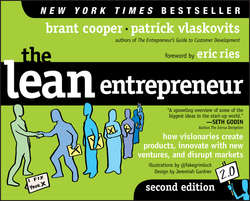Читать книгу The Lean Entrepreneur - Vlaskovits Patrick - Страница 5
На сайте Литреса книга снята с продажи.
Foreword
ОглавлениеWhen I first started blogging in August 2008, I had no idea what to expect. Startup blogging was hardly cool back then. Plenty of venture capitalists advised me against it.
My personal background was as an engineer, and my companies had been web-based startups, so that is what I wrote about. Struggling to explain the successes and failures of those companies, I discussed principles like continuous deployment, customer development, and a hyper-accelerated form of agile. When I delved into lean manufacturing, I discovered that the concepts and terminology dovetailed. The result: a new idea I called the Lean Startup.
I started with some basic theory: that a startup is an institution designed to thrive in the soil of extreme uncertainty, and that traditional management techniques rooted in forecasting and planning would not work well in the face of that uncertainty. Therefore, we needed a new management tool kit designed explicitly for iteration, scientific learning, and rapid experimentation.
At the time, I viewed it as incidental that the theory might be tied to a particular industry, such as high-tech startups or web-based environments. Lean, after all, emerged from Toyota, a huge automobile manufacturing company. I simply stated my belief that Lean Startup principles would work in other types of startups and in other areas of business where uncertainty reigned.
Boy, was I unprepared for what happened next. I was hopeful that we would change the way startups are built – but I didn’t know.
Fast-forward more than seven years, and I’m astounded by what has emerged. A nascent community has blossomed into a full-fledged movement. Entrepreneurs, both new and experienced, proudly share their Lean Startup learning in case studies, conferences, and many, many blogs. Books, workshops, and courses written and led by passionate practitioners relate experiences, share insights, and create tools to teach students ways to make Lean Startup principles their own. Many investors, advisors, mentors, and even celebrity entrepreneur icons speak the Lean Startup language.
It’s a big tent. We stand on the shoulders of giants: customer development, the theory of disruptive innovation, the technology life-cycle adoption theory, and agile development. Complementary lines of thinking, such as that of user experience professionals, design thinking practitioners, and the functional disciplines of sales, marketing, operations, and even accounting, come together to share practices that lift us all.
Lean Startup has gone mainstream. I wish I could say that this was all part of some master plan, that I knew all along that companies of all sizes – even those far outside the high-technology world – would embrace Lean Startup. I wish I had foreseen that within a year of publishing The Lean Startup: How Today’s Entrepreneurs Use Continuous Innovation to Create Radically Successful Businesses, many large organizations, including such monsters as the U.S. federal government (!), would have recognized that to cope with today’s world – faster, more competitive, and inundated with data – new methods are needed to keep up. The truth is that all of this change has happened faster and more thoroughly than any of us imagined. And – as you’re about to see – we’re just getting started.
That’s why I am so excited by this book you hold in your hands. The Lean Entrepreneur is about these new methods. Brant Cooper and Patrick Vlaskovits are among the earliest adopters of new ideas such as Lean Startup and customer development. Their new work turns their lens on three primary focal points: how to interact with customers, run experiments, and use actionable data to move the needle of any uncertain business endeavor.
As with all of their work, theirs is not just a book of theory. Brant and Patrick provide great tactical depth in each of these areas.
They endeavor to answer the question: No matter where you are as an organization, how do you know where to focus your Lean Startup activities? The Lean Entrepreneur offers new thinking, tools, and activities that help organizations identify and act upon business model challenges in a waste-eliminating manner. Following the precepts of traditional lean thinking, Brant and Patrick introduce the Value Stream Discovery process, which helps organizations hypothesize what they must do, including product development, marketing, and sales, in order to create value. These business model assumptions are then ripe for testing, measuring, and iterating upon.
Further, the value you create is meaningless without a customer who needs, wants, desires, and, ultimately, determines the final value of your creation. Brant and Patrick spend considerable time helping you think through your customer segments. Cleverly, and in the spirit of the scientific method, they even help you discover where your customer theory is wrong.
Everyone likes a good story; Brant and Patrick interviewed dozens of entrepreneurs and documented numerous case studies both inside and outside of high technology, in both startups and large enterprises. There’s even a classic Wizard of Oz minimum viable product that dates back to 1998!
Make no mistake: Brant and Patrick have been here since the beginning. They self-published The Entrepreneur’s Guide to Customer Development in April 2010.
From the outset, they were both practitioners and mentors, urging entrepreneurs not to follow a paint-by-numbers approach, but rather to think lean: fast, agile, and continuously learning. Over the past two years they’ve traveled around the world speaking, advising, and teaching Lean Startup.
The Lean Entrepreneur is an important addition to the growing library of principles and practices designed to improve how we tackle innovation and uncertainty, be it in high-tech startups, Fortune 100 companies, nonprofits, or government offices.
I consider myself lucky to count Brant and Patrick as friends and colleagues. It is my hope that from this book you will gain valuable insights, that you make Lean Startup your own, and – much more important – that you are successful in changing the world for the better.
Eric Ries
San Francisco
January 2013
